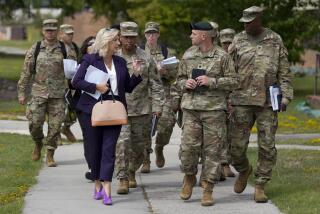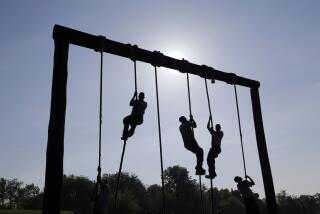Prep Schools Offer the Otherwise Unqualified Paths to Service Academies : Education: Taxpayers cover one-year programs that allow late bloomers, women, minorities and athletes a chance to transform themselves.
- Share via
ANNAPOLIS, Md. — Eric Ver Hage, by his own admission, was a lousy high school student and a troublemaker who earned “almost ridiculously low grades.”
He finished near the bottom of his class of 310 at Mechanicsburg, Pa., and didn’t have enough credits to graduate.
Six years later, Ver Hage is entering his senior year at the U.S. Naval Academy, where he ranks in the top third of his class.
A change of heart and a lot of hard work helped Ver Hage make the transformation from high school goof-off to successful scholar.
So did a $40,000, one-year prep school education financed by taxpayers.
Ver Hage, like generations of naval officers before him, is a graduate of the 75-year-old Naval Academy Preparatory School (NAPS) in Newport, R.I. It is run by the Navy solely to qualify students for the Naval Academy and the Coast Guard Academy.
The Army and Air Force have similar schools that serve as feeder schools for their academies.
The armed forces spend more than $20 million annually to prepare about 800 young men and women for the service academies, while each year the academies turn away hundreds of qualified applicants. In fact, prep school graduates make up about 15% to 20% of the cadet corps.
“We wire-brush them, get them all shined up, get the brass looking good and then we deliver them,” says Capt. Thomas P. Danaher, director of the Navy prep school.
Generally, the prep schools have gone about their business with little interference from the outside. But now Congress has asked the General Accounting Office to look at the three schools and submit a report next year.
“Congress just wants to know if the schools are doing their job well and if the money is being well spent,” says James Schweiter, a staff aide with the House Armed Services Committee.
Some prep school students, such as Ver Hage, are late bloomers seeking a second chance. Others are minorities whose grades and test scores are too low.
Still others are athletes recruited to play sports.
Schweiter says some members of the committee have questioned whether prep schools are improperly used to groom intercollegiate athletes. The GAO study may answer that question, he says.
The Navy prep school, the oldest of the three, began in 1915 with 13 enlisted men as students.
“It was a very small school to provide a commissioning path for enlisted men,” says John W. Renard, dean of admissions at the academy.
The original mission of the schools was to help men and women from the regular Army, Air Force and Navy enter the academies. But the role has been expanded in recent years to help athletes and minorities qualify for the academies.
Prep schools also offer a way into the academies for students who do not follow the normal admission route, a nomination from a member of Congress.
Despite the cost, there is no talk at the academies of cutting back or eliminating the prep schools even in a time of tight money and dwindling military budgets.
The academies are not short on applicants.
At the Naval Academy, more than 12,000 applied for admission this year. More than 2,000 of them qualified scholastically, medically and physically for the 1,232 openings in the class of 1994.
Renard acknowledges that he could easily fill the class each year without the prep school.
“But would I want to? The answer is no,” he says.
Students at prep schools may have had shaky academic records in high school, but they are bright and often have the motivation and leadership qualities that produce the best officers, Renard says.
Officials at all three schools emphasize the importance of the prep schools to their efforts to enroll minorities. They say prep school graduates add a diversity that would not exist if the academies restricted enrollment to the top scholars.
The Air Force Academy “just couldn’t meet our minority recruiting goals” without the prep school, says Col. James Wright, head of the Air Force Academy Preparatory School at Colorado Springs, Colo.
“If you close the prep school, you eliminate a source of entry to West Point . . . for soldiers, for minorities, for some females who wouldn’t otherwise have a chance to go,” says Col. Jim Orahood, commandant of the U.S. Military Preparatory School at Ft. Monmouth, N.J.
“You need all these segments of society,” he says. “Minorities don’t come from the best schools as a group. We do want to keep them in the mainstream of our military, and often this is the best way for them to get in.”
Orahood is a walking advertisement for the Military Academy Preparatory School. The West Point graduate returned to Ft. Monmouth as its commanding officer 26 years after he graduated from the prep school.
“I came from one of those small high schools,” he says. “There were 20-something in my class. I didn’t know what a slide rule was. I didn’t know calculus.”
The prep schools say their graduates often go on to become medal winners, war heroes and top-echelon officers.
Astronaut Loren Shriver is a graduate of the Air Force prep school. So is Graham Shirley, who flew 200 combat missions in Vietnam and rose to the rank of brigadier general.
The Naval Academy prep school numbers among its graduates Vice Adm. Joseph Metcalf, now retired, who commanded U.S. forces during the invasion of Granada, and Vice Adm. Frank Donavan, currently commander of the Military Sealift Command.
All three academies use the prep schools to boost their athletic programs.
“We would not be able to field the athletic teams that we do” without prep school, Wright says.
“We need every little edge we can get because of the high academic standards at the academy,” says Jack Lengyel, Navy’s athletic director.
“If an athlete meets normal admission standards but the academics are shaky, then we will offer the athlete the prep school,” Renard said.
That was the case with John Casey, a junior from Doylestown, Pa. He was asked to go to prep school when he was recruited to row on Navy’s crew team.
“That was fine with me,” he says. “I figured that would give me a good background for my military training and boost my academics.”
Mark Smith, a wrestler from Holt, Mich., went the prep school route because he made a last-minute decision to attend the Naval Academy instead of Michigan State.
“I called the academy, and they said they were interested,” Smith says. “They said they could get me into NAPS on short notice. It was a great avenue for me.”
By accepting appointment to the prep school, students commit themselves to military service whether they go on to the service academy or not.
If they pass the course, they are virtually guaranteed appointment to one of the academies.
If they don’t pass, they become part of the regular military service as enlisted personnel.
All prep school students take the same basic course--two units of math, one of English and one of science. Students also begin military training.
Those who go on to an academy graduate at about the same rate as those who enter directly from high school or college.
Prep schools say their graduates tend to stay in the military longer than other academy students.
A study by the Army showed retention rates higher by 5% to 10% at key landmarks such as five years, when academy graduates can first leave the service, and 20 years, the first retirement mark.
Prep schools require applicants to commit an extra year of their young lives to the military.
“My brother had gone that route. He recommended it,” says Chris Oddo, a junior at the Naval Academy.
“I didn’t think I had the grades to get in here first. I don’t think I could have made it here” without a year at NAPS.
More to Read
Sign up for Essential California
The most important California stories and recommendations in your inbox every morning.
You may occasionally receive promotional content from the Los Angeles Times.










